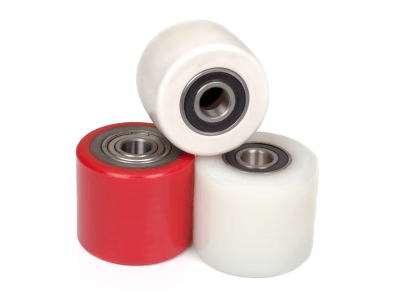What Is a Polyurethane Bearing?

Polyurethane bearings are bearings made primarily of urethane resin (polyurethane). These bearings reduce friction between mechanical parts and support rotating shafts, enabling smooth rotation and precise motion. Polyurethane bearings are known for their high wear resistance and longevity, maintaining performance over extended periods. They are also lightweight, contributing to reduced component weight and improved energy efficiency. With a smooth surface and low friction operation, they enable efficient movement of moving parts.
Chemically stable, polyurethane bearings are suitable for corrosive environments but have a lower load-carrying capacity compared to metal bearings, necessitating careful design and selection.
Applications of Polyurethane Bearings
Polyurethane bearings are versatile, and used in various applications due to their specific characteristics:
1. Light-Load Mechanical Parts
These bearings are ideal for lightweight mechanical parts, such as rollers in conveyors, where lightweight and low friction are crucial for transporting products and materials.
2. Low-Speed Moving Parts
Suitable for low-speed moving parts, polyurethane bearings are utilized in mechanical fingers for product insertion and assembly, providing smooth motion and precision during low-speed operations.
3. Food and Medical
In food processing machinery and medical equipment, the sound-absorbing properties of urethane make these bearings suitable for applications requiring vibration and noise control. This minimizes impact on the working environment and maintains cleanliness and smooth motion in food and medical equipment.
Principle of Polyurethane Bearing
Polyurethane bearings operate by reducing friction and providing support based on their properties. Urethane resin is flexible, elastic, and typically has a low coefficient of friction, allowing for smooth motion and minimal energy loss. Additionally, urethane’s ability to absorb vibration and shock helps reduce noise and vibration during operation, making these bearings ideal for quiet work environments or applications where vibration minimization is critical.
While suitable for light loads, low-speed motion, and vibration/noise control, polyurethane bearings require appropriate materials and designs for high loads and high-speed operations.
How to Select Polyurethane Bearings
Consider the following when selecting polyurethane bearings:
1. Urethane Hardness
The hardness of the polyurethane affects wear resistance and load capacity. Harder urethanes offer higher wear resistance, while softer ones provide better shock absorption. Choose hardness based on the application, with harder urethanes for load-bearing applications and softer for vibration absorption.
2. Urethane Types
Different types and compositions of urethane are available. Select based on characteristics like oil resistance, abrasion resistance, and quiet operation.
3. Operating Temperature
Consider urethane’s heat resistance limits, as it may deform or deteriorate in high temperatures. Choose polyurethane suitable for the operating temperature or consider alternative materials if necessary.
4. Dimensions
Proper dimensions, including shaft diameter, outside diameter, and width, are crucial for ensuring smooth operation and correct mounting within the equipment.